USA
Plants and Animals

Plants and Animals

Cities in USA
| Atlantic city | Boston | Dallas |
| Detroit | Las vegas | Memphis |
| Nashville | New york | Seattle |
Popular destinations USA
| Arizona | California | Florida |
| Hawaii | Utah |
Plants and Animals
Plants
The native flora of the northwestern United States has suffered greatly from land reclamation. Originally man-sized grasses, with the so-called 'tall grass' (1.5-2 meters high), grew in Iowa and Kansas on the extensive grass plains. The original vegetation is still protected in the Konza Prairie Research Natural Area near Topeka.
More to the west on higher and poor soil grows "short grass", a shorter variety.
Desert-like conditions prevail in parts of the states of Idaho, Oregon, Washington, and Wyoming, where sage bushes predominate. The eastern grass plains have meanwhile developed into agricultural areas, while livestock farming predominates in the western parts. Due to the abundant rainfall, the western slopes of the Rocky Mountains are covered with beautiful forests: red cedars, Douglas firs and redwoods.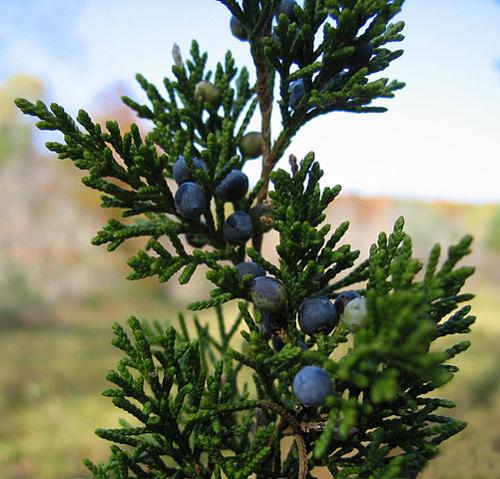 Red cedar or Virginia juniper, USAPhoto: Keith Kanoti, Maine Forest Service, USA CC 3.0 no changes made
Red cedar or Virginia juniper, USAPhoto: Keith Kanoti, Maine Forest Service, USA CC 3.0 no changes made
Minnesota is largely covered with forests. Walnut, oak, birch, and pine trees are ubiquitous, and on dry rocky soils grow cedars, white spruce, balsam, and hemlock. Wetlands, lake and river banks are the beloved habitat of black spruce, American larch, and western trees of life. Shallow inlets adorn themselves with yellow-flowering plumps, snake root and bulrushes. The national flower of Minnesota is the "pink lady's slippers", an orchid variety of women's shoes. The forests in Washington and Oregon consist of the western hemlocks, red cedars and, at higher altitudes, Engelmann spruces and lodge poles.
In the rainforests on the coastal area, cedars and hemlock spruces grow to exceptional sizes, but Douglas fir and Sitka spruces also reach a length of 100 meters and a size of 4-5 meters. The bottoms are covered with mushrooms, (rind) mosses and ferns. On the plateaus between the mountain ranges, deciduous forest with maples and oaks predominates. Southwest Oregon is home to the famous redwood and giant sequoia trees. The Colorado Plateau is dominated by sage bushes.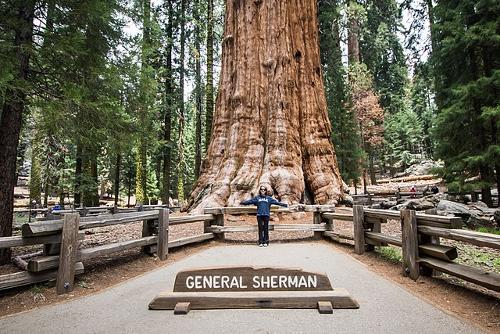 'General Sherman' Sequoia tree, USAPhoto: M01229 CC 2.0 Generic no changes made
'General Sherman' Sequoia tree, USAPhoto: M01229 CC 2.0 Generic no changes made
Outside South Dakota's "badlands", mixed and short-grass prairie dominates, one of the few well-preserved remains of the Great Plains grasslands. More than fifty varieties of grass are found here, with low buffalo grass, "blue grama" and bluish "western wheatgrass" being the most common. More than two hundred species of herbaceous flowering plants grow in between. Rocky Mountains are home to juniper berries and red cedars.
The North Dakota prairies are very similar to those of the southern neighbor, but very surprising in these northern latitudes are hardy red-fruited fig cacti. Tall poplars and willows grow along Little Missouri.
About 1100 plant species are found in the famous Yellowstone National Park. In the wooded areas conifers and especially the murrayana pines dominate. The other vegetation types range from semi-arid forest land to marshes, marshlands and alpine mountain pastures. In the Yosemite Valley, yellow pines, Jeffrey pines, libocedars, California black oaks and large-leaved maples form a mixed forest. In the rest of the park, conifers determine the vegetation image.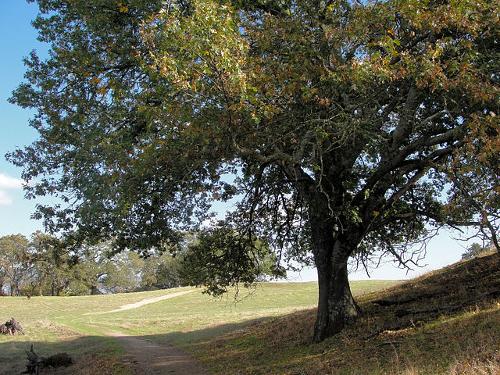 California black oak, USAPhoto: Miguel Vieira from Walnut Creek, CA, USA, CC 2.0 no changes made
California black oak, USAPhoto: Miguel Vieira from Walnut Creek, CA, USA, CC 2.0 no changes made
The Glacier National Park in Montana has two climatically different halves, which affect the vegetation. For example, western hemlock and giant life trees grow only in the McDonald Valley located to the west of the mountains. White pines and American aspen poplars grow in the eastern valleys. Engelmann firs and Douglas firs control the montane forests, and murrayana pines occur in drier forests. Alpine silver firs and white bark pines form the tree line in the alpine zone. Bear grass grows in many places, lily-like plants that can grow up to 90 cm high.
Temperate rainforest is found in the most northwestern state of Washington, with the Sitka spruce as a characteristic tree. The large-leaved maple is typical and often very densely overgrown with countless mosses, lichens and ferns. English dewclaw moss hang in dense curtains from the branches. The undergrowth is formed by sword fern and ponytail, along with some flowering plants. More giant silver firs are found in the drier lowland forest.
The higher you go, the more western weymouth pines, Pacific silver pines and nut cypresses come to the fore. In the undergrowth various berry bushes and the pink colored, rare wood nymph from the orchid family thrive. Even higher are meadows with blue lupins, deep red "magenta paintbrushes" and bright purple bushes.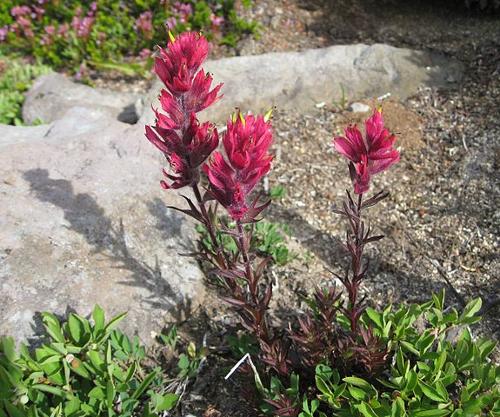 Magenta paintbrush, USAPhoto: J Brew CC 2.0 Generic no changes made
Magenta paintbrush, USAPhoto: J Brew CC 2.0 Generic no changes made
In the mountainous northeastern part of California, under 2,000 meters high-stemmed yellow pines, Jeffrey pines and Colorado silver firs dominate. The sometimes man-sized red-stemmed "greenleaf manzanita", a bear grape variety, forms a dense undergrowth. Bushes of libocedars and male pines grow in warm places with cones about 50 centimeters long.
In Sequoia / Kings National Park, the elevation ranges from 500 meters to over 4,000 meters, resulting in different climate and vegetation zones. Striking in the promontory (500-1400 meters) are the blue glossy "blue oaks", the California chestnut and the yucca variety "our Lord's candle". The montane vegetation zone (1400-2500) is the realm of the giant sequoia trees, which are divided into 75 small forests. The forests in the lower belt of the subalpine and alpine vegetation zone (from 2500 meters) are characterized by beautiful silver pines, murrayana pines and foxtail pines, above 3300 meters the vegetation turns into alpine meadows. Tiger lilies grow near forest streams or springs.
The alpine vegetation zone or tundra extends above the treeline (from 3,400 meters) in the mountain areas of Colorado. Frost, storm and snow here limit the vegetation to low tree plants. More than a hundred flowering plant species take advantage of the vegetation period of only eight to ten weeks: examples include "alpine avens", a nail herb species, "alpine sunflowers" and the Arctic gentian.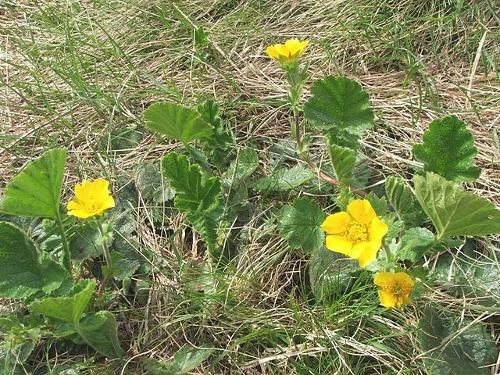 Alpine avens, USAPhoto: Opiola Jerzy CC 3.0 Unported no changes made
Alpine avens, USAPhoto: Opiola Jerzy CC 3.0 Unported no changes made
In the southeastern United States, evergreen trees grow, such as American oak (the national tree of the United States), maple, beech, chestnut, ash, birch, elm, walnut, linden, and magnolia. However, pine and swamp forests are predominant. Wetlands can be divided into "marshes", with spicy vegetation, and "swamps", with shrubs and trees, especially cypresses. In North Carolina and the Gulf States, unique Spanish moss grows, rootless plants that live on oaks and cypresses. They are so-called epiphites, so they do no damage.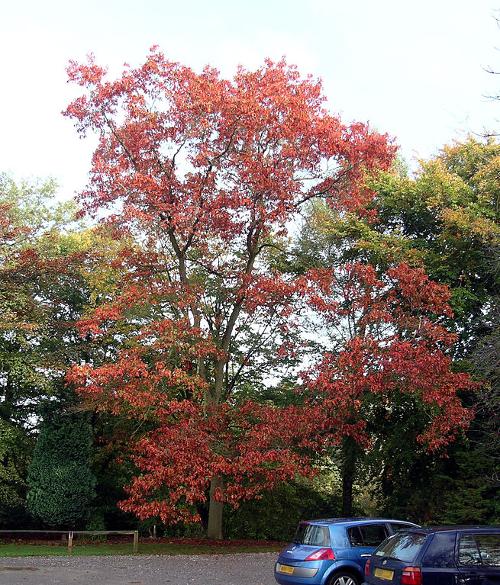 American or red oak, national tree of the USAPhoto: 'Velela' in the public domain
American or red oak, national tree of the USAPhoto: 'Velela' in the public domain
In the Everglades and in parts of South Louisiana, different types of mangroves occur, easily recognizable by the aerial roots and evergreen leaves. In the brackish water one finds red, white, black and button mangroves. Tropical crops such as 'gumbo limbo', mahogany trees, royal palms and 'strangler figs' dominate on slightly higher tree islands or 'hammocks'. Climbers, bromeliads, orchids and a partly dense undergrowth of ferns and mosses create their own microclimate.
Water- and nutrient-rich basins form growing places of bald cypress, akin to redwoods and giant sequoias. Lush vegetation of Spanish moss, stiff-leaved wild pine, orchids and other epiphytes makes for a special sight. Higher lying limestone ridges are covered with woods of hybrid pine. The floodplains of the Mississippi area have wooded vegetation with maples, cottonwood, and cypress and gum trees to the south. The mossy "bogs" are a bit further north.
The Great Smoky Mountains, the highest mountains in the Appalachians, have fertile soil, abundant rainfall and a height difference of almost 1800 meters, a flora full of variety with almost 1600 species, of which 123 tree species alone. Deciduous forests dominate the lower park zone, including white maples, yellow birches and magnolia trees. Above 1400 meters we find American beech trees and also yellow birches. In spring, a wide variety of rhododendrons also bloom here, as well as the mountain laurel, calico-brush, or spoonwood.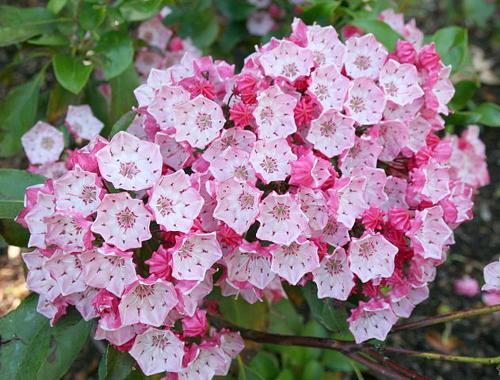 Mountain laurel, calico-brush or spoonwood, USAPhoto: A. Barra CC 3.0 Unported no changes made
Mountain laurel, calico-brush or spoonwood, USAPhoto: A. Barra CC 3.0 Unported no changes made
The northeastern part of the United States is densely forested, especially New England where about 80% of the country is covered with forests. Pennsylvania and New York are also forested, but not with original forests.
New deciduous forests have been created to the east of the Appalachians, with many European tree species such as chestnuts, beech, oak, poplar and birch, as well as American aspen, paper birch and American beech. Many conifers grow in New Hampshire and Maine, with the characteristic tree being the sugar maple or maple tree, as well as red spruce, balm spruce and pitch pine, a tough variety that grows on rocky soils. Many apple, pear and cherry orchards have also been planted in this region. Furthermore, many berry bushes, including the famous "cranberry" (cranberry). Some tobacco is also grown.
South of New York, the moderately moist deciduous forest turns into spruce forests. Poison ivy is found throughout the eastern United States, which can cause severe skin inflammation and blisters.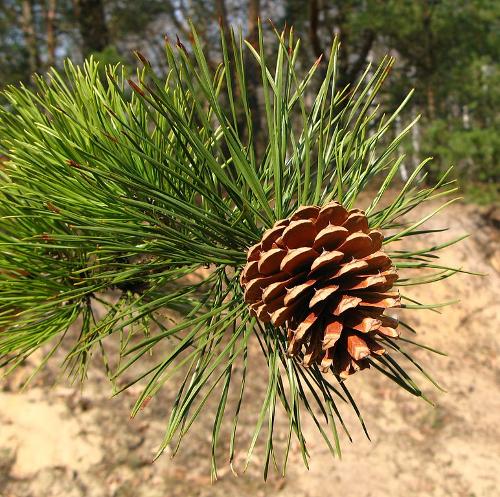 Pinus rigida or pitch pine, USAPhoto: Crusier CC 3.0 Unported no changes made
Pinus rigida or pitch pine, USAPhoto: Crusier CC 3.0 Unported no changes made
The diverse ecosystems in the southwestern United States provide a very diverse flora. For example, along the northern coast of California, the redwoods or Sequoia sempervirens, the tallest trees in the world, grow to 112 meters high. In the precipitation-rich Sierra Nevada grow the somewhat small but much larger Sequoiadendron giganteum that can become thousands of years old.
Pine and cedar forests predominate in the mountain areas. Very special is the desert vegetation with, for example, the "Joshua tree", a relative of the yucca. Slightly smaller are the characteristic saguaro cacti (up to 15 meters high) in the Sonora Desert. The Sonora is covered with drought crops such as the mesquito trees, thorn broom trees and extremely hard ironwood. Very common dwarf shrub species are the creosote shrubs, the "white brittlebush" and the rare otillos. The lechuguilla is an agave species that was used by the desert inhabitants for all kinds of things. The very prickly cholla cactus is dangerous to humans. Other cactus species include the bulky ferocacti, "Engelmann's pricklypears", organ pipe cacti and Senita cacti. The northern parts of the Great Basin ("sagebrush country") are poor in vegetation, with some wormwood bushes here and there.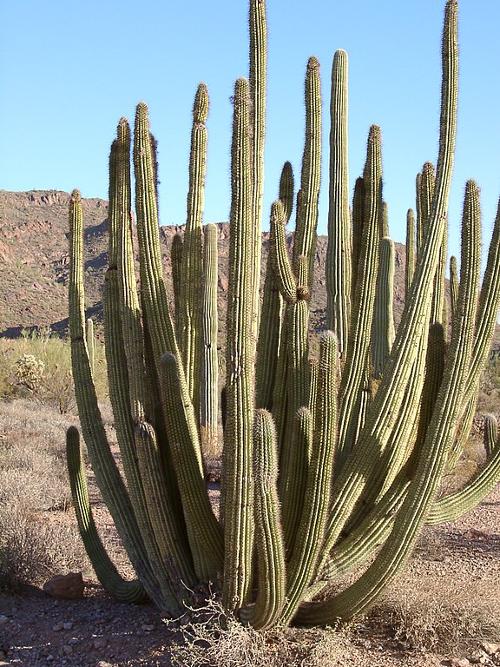 Organ pipe cactus, USAPhoto: Pretzelpaws CC 3.0 Unported no changes made
Organ pipe cactus, USAPhoto: Pretzelpaws CC 3.0 Unported no changes made
Creosote shrubs, thorny "catclaw" acacias and mesquito trees are found in the lowest, driest places in the Grand Canyon. Utah's high-altitude drought regions are covered in pin pine, Utah junipers, yellow pines, Colorado silver firs, Douglas firs, and American aspen poplars. Various willow species, feather maples and vines belonging to the vine family grow along the watercourses. Bryce Canyon National Park is home to white pines and Great Basin hickory pines, which are among the oldest plants in the world, on rocky crests and sandy soils. The age is estimated at 4600 years. Prince's plumes are among the cruciferous and are very poisonous. Grasses such as "Indian ricegrass" are important food sources for mammals and birds.
The characteristic plants of the Chihuahua desert in New Mexico grow in the above-ground part of the national park. Lechuguilla agaves, ocotillos, torrey yuccas and the smaller soaptree yuccas, the national flowers of New Mexico, are numerous. In the shelter of the canyons, around the waterholes and in the higher regions, you will also find larger shrubs and trees, including "desert willows", Texas walnuts and the evergreen "one-seed junipers".
In the Texan part of the Chihuahua desert, drought bushes dominate, the creosote shrub being the most numerous. In the shelter of this plant grows the "Christmas cactus", one of the seventy cactus species of the Big Bend National Park. Special is the "candelilla", a spurge crop. In the slightly higher part, the largest yucca, the "giant dagger yucca", grows.
Evergreen "Texas madrones", a type of strawberry tree, "Mexican pinyons", three juniper and many oak species grow in the more rainy Chisos Mountains. The banks of the Rio Grande are bordered by a reed belt, from which the 4.5 meter high arrow reed protrudes.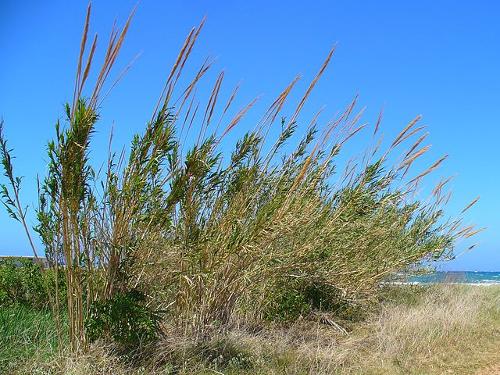 Giant, Spanish or wild cane, USAPhoto: H. Zell CC 3.0 Unported no changes made
Giant, Spanish or wild cane, USAPhoto: H. Zell CC 3.0 Unported no changes made
Animals
MAMMALS
North of Mexico we find nine orders of land and amphibious mammals with about 370 species. Of these, about 20 species are found only in Alaska (and Canada), such as dog collar, arctic fox, polar bear, musk ox and various seals. Southern species such as the collar peccary and the Allen donkey hare are only found in the United States.
The order of the marsupials is represented by only one species, the Virginian possum. The order of the armadillos has only one species, the nine-banded armadillo. The last order with only one species is that of the manatees, the Caribbean manatee.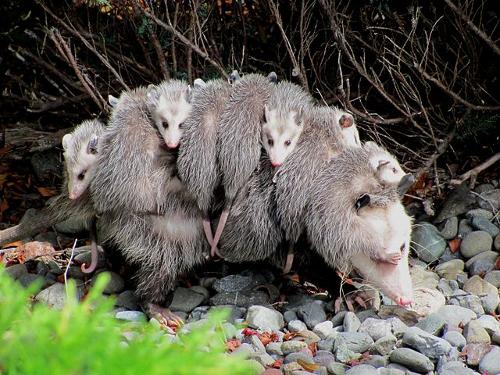 Virginia or North American opossum, USAPhoto: Specialjake CC 3.0 unported no changes made
Virginia or North American opossum, USAPhoto: Specialjake CC 3.0 unported no changes made
Insect eaters are 37 species from the shrew and mole families.
Widespread is the order of the bats with about 40 species. The guano bat is found throughout the Southwestern United States. At the Bat Cave of the Carlsbad Caverns in New Mexico, a spectacular scene can be seen every night. Tens of thousands of these bats curl up in the evening sky and hunt for insects.
The nineteen species of lagomorphs of North America also include the American pika or whistling hare family.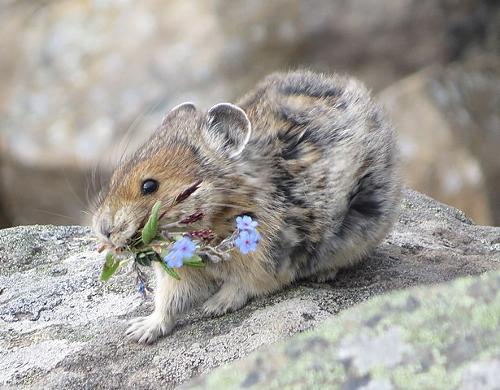 North American pika, USAPhoto: Frédéric Dulude-de Broin CC 4.0 International no changes made
North American pika, USAPhoto: Frédéric Dulude-de Broin CC 4.0 International no changes made
Rodents are common everywhere with about 200 species. These include stump-tailed squirrels, black-tailed prairie dogs, yellow-bellied marmots, chipmunks, cheek rats and mice, the Canadian beaver, jumping mice, the North American porcupine and the coypu. Tree squirrels include red squirrels, chikarees and fly horns. Order kangaroo sacrifices jump like kangaroos.
The predators include black and brown bears, cougars, North American raccoons, silver badgers, coatis, North American cat ferrets, coyotes, red lynx, the striped skunk, the rare ocelot, and equally rare black-footed polecat. The gray wolf is more common in Minnesota. The best known amphibious predators are the California sea lion and the harbor seal.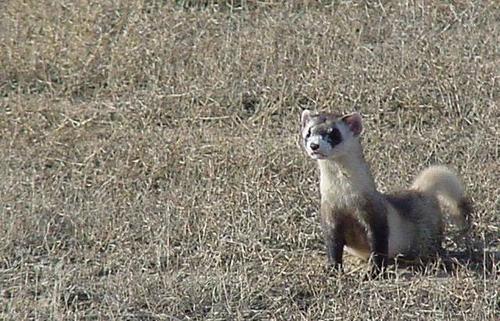 Black-footed ferret, USAPhoto: Black, Tami S, U.S. Fish and Wildlife Service in the public domain
Black-footed ferret, USAPhoto: Black, Tami S, U.S. Fish and Wildlife Service in the public domain
The cloven-hoofed animals are represented with fifteen species, including white-tailed deer, red deer, mule deer, bighorn sheep, moose, snow goats and bison. Gaff antelopes, the fastest mammals in North America, live in the northwest.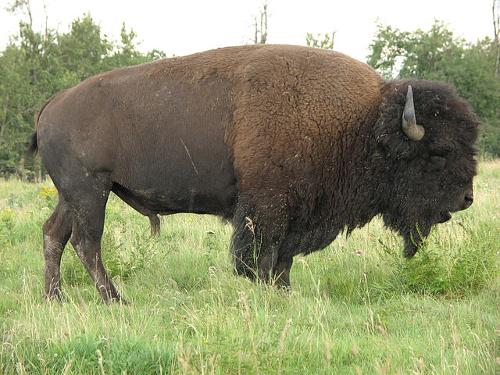 Bison, national animal of the USAPhoto: Ceasol CC 2.0 Generic no changes made
Bison, national animal of the USAPhoto: Ceasol CC 2.0 Generic no changes made
BIRDS
Of the approx. 750 bird species, about 620 breed in North America. Some of the 73 families represented in total are distributed worldwide, including raptors, falcons, duck-like, herons, pigeons and owls, including the rabbit owl one of the smallest birds of prey in the world (12-14 cm). Also special are the burrowing owls that occur in South Dakota and the spotted tawny owl in the redwood forests.
Others only occur in the Northern Hemisphere, such as the waxwings, tree creepers and sea divers. Only one family is found only in the United States and Central America: the turkeys.
Birds of prey come in many varieties, for example red-tailed hawk, hen harrier, golden eagle, peregrine falcon, prairie falcon, osprey and the national bird of the United States, the bald eagle. Scavengers are the turkey vulture and the black vulture.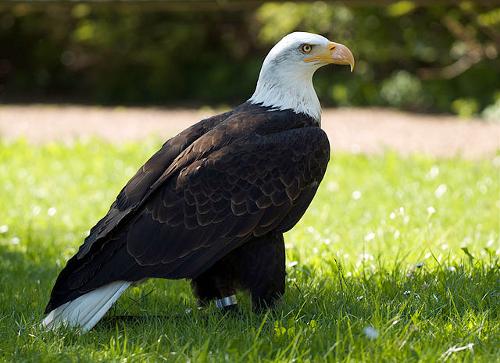 Eagle, national bird of the USAPhoto: Jörg Hempel CC 3.0 Germany no changes made
Eagle, national bird of the USAPhoto: Jörg Hempel CC 3.0 Germany no changes made
Nearly all birds in the New World are centered for distribution in South and Central America, and only occasionally visit the southern United States, such as the cotingas, the hokko's and the trogons.
Some families, however, penetrate into Alaska and breed in North America, such as Kurlans, vultures (including the nearly extinct California condor), troepials (including the Brewer's black troopial and the Baltimore troopial), mock thrushes, white-tailed snow fowl, forest warblers, tangaras, hummingbirds, wren, tyrants and vireos.
Florida is a true bird paradise with white and blue herons, gray-headed storks, snake-necked birds, roseate spoonbills, harriers, kites, waders, plovers, sea and osprey.
Yellowstone National Park is home to Canada geese, American white pelicans and rare trumpeter swans.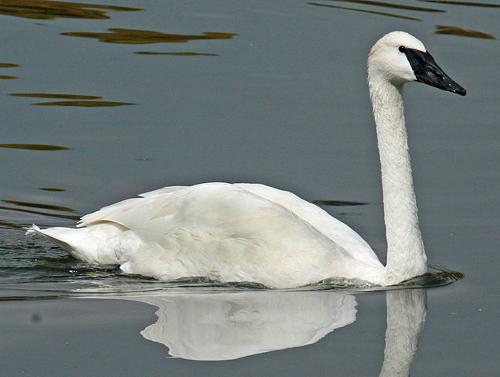 Trumpeter swan, rare in the USAPhoto:Dick Daniels (http://carolinabirds.org/ CC 3.0 Unported no changes made
Trumpeter swan, rare in the USAPhoto:Dick Daniels (http://carolinabirds.org/ CC 3.0 Unported no changes made
The Everglades National Park is home to about 350 bird species, including red spoonbills, white ibises, American white pelicans, American snake neck birds, all twelve North American heron species, ospreys, red-shouldered buzzards, turkey and black vultures, epaulet starlings, boat tails, red-crested black woodpeckers, swamp kites and the rare gray-headed storks.
Helmeted quail, cactus wren, crested spot thrushes, racing cuckoos and American gray shrike live in the Sonoran desert.
The extreme northwest of the United States includes blue ptarmigan, pink finches, gray juncos, variegated thrushes and brown hummingbirds. On the Great Ocean Coast you will find Bering Gulls, Pelagic Cormorants, Guillemots, Rhino Puffins and Pigeon Guillemots.
In the past centuries, extinct giant auks, Labrador ducks, Carolina parakeets, migratory pigeons, eskimo curlews and the ivory beak have once been the largest woodpecker in the world.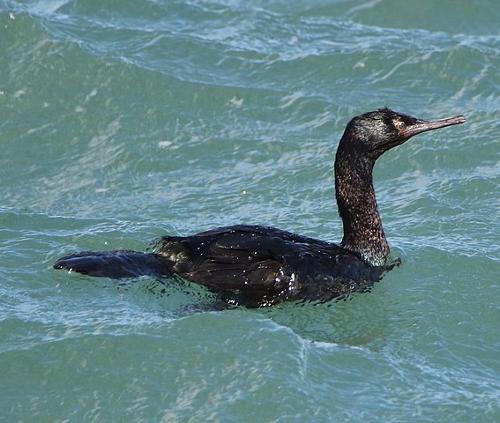 Pelagic or Baird's cormorant, USAPhoto: Alpsdake CC 4.0 International no changes made
Pelagic or Baird's cormorant, USAPhoto: Alpsdake CC 4.0 International no changes made
REPTILES
North America has approximately 290 species of reptiles, of which rattlesnakes, Mississippi alligators and gila monsters (poisonous lizard species) are the most notable and dangerous. There are also about fifty species of turtles, including the diamondback turtle in Texas, the giant alligator turtle (up to 100 kg) and the desert turtle.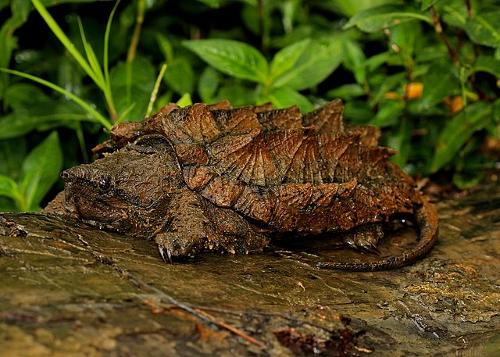 Alligator snapping turtle, USAPhoto: Peter Paplanus CC 2.0 Generic no changes made
Alligator snapping turtle, USAPhoto: Peter Paplanus CC 2.0 Generic no changes made
Iguanas include deaf iguanas, desert spines, collared iguanas, chuckwallas, short horned lizards, renal lizards and toad lizards. In the eastern United States, the striped skink is widespread.
The fairly rare American beaked muzzle crocodile is only found in the brackish waters of South Florida.
AMPHIBIANS
In North America about 200 species of amphibians are found. The order of the salamanders includes the axolotls and the lungless salamanders. The Pacific giant salamander occurs in the western redwood forests, among others. The family of curious, external gill-bearing sirens are found only in North America.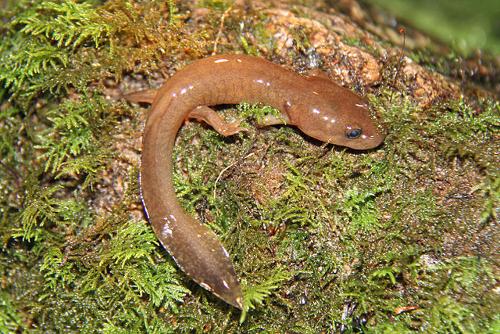 California giant salamander, USAPhoto: Greg Schechter CC Attribution 2.0 Generic no changes made
California giant salamander, USAPhoto: Greg Schechter CC Attribution 2.0 Generic no changes made
Frog-like species include the American garlic toad, the bull frog, the giant toad from Central America, and the many tree frog species (including the Pacific tree frog). The mountain yellow-legged frog, a brownish frog with a striking yellow-orange belly, can be found up to 3600 meters in California.
FISH
The seas around North America still have a great wealth of fish. In the eastern waters, fishing is mainly for herring, plaice and cod, in the east for salmon, tuna and sardine.
On the banks of many rivers, fishing for Pacific salmon is done by both humans and bears. Other freshwater fish include blue-backed salmon, rainbow trout and sea trout.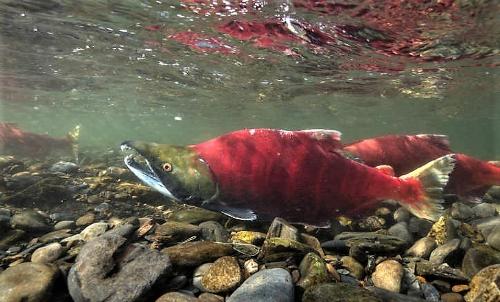 Sockeye salmon, USAPhoto: US Fish & Wildlife Service in the public domain
Sockeye salmon, USAPhoto: US Fish & Wildlife Service in the public domain
A special ocean inhabitant in the northeastern United States is the horseshoe crab, living fossils and the last examples of an animal group that appeared en masse 500 million years ago.
INVERTEBRATES
About 100,000 species are known in North America, including mosquitoes, ringworms (including the black ringworm in the northeastern state of Washington), butterflies and spiders (including tarantulas and black widows). Slugs up to 6 inches (15 cm) long live in western Washington State.
Sources
Phillipson, O. / USA
Heinemann Library
Sandak, C.R. / Verenigde Staten van Amerika
Corona
Stanic, S. / De Verenigde Staten
Schuyt & Co
Supermachten
Stichting Teleac 1: Verenigde Staten van Amerika
Verenigde Staten
Uitgeversmaatschappij The Reader’s Digest NV
Webb, M. / The United States
Lucent Books
CIA - World Factbook
BBC - Country Profiles
Last updated June 2025Copyright: Team The World of Info